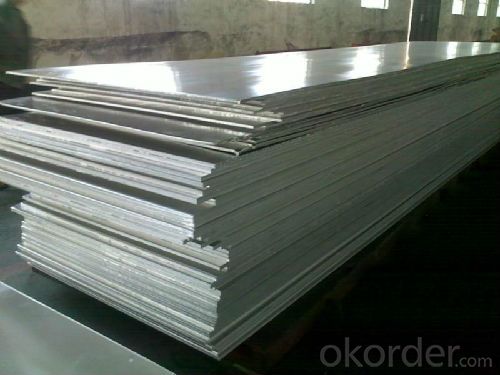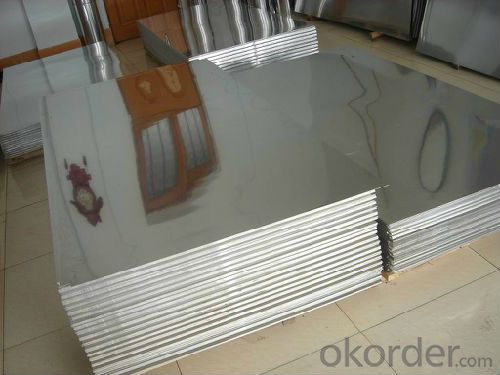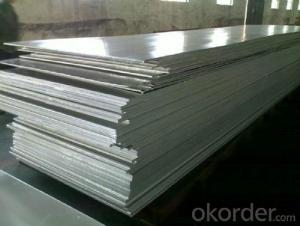Aluminium Coils/Sheet AA1050 AA1060 AA1070 AA1100
- Loading Port:
- Shanghai
- Payment Terms:
- TT OR LC
- Min Order Qty:
- 3 m.t.
- Supply Capability:
- 9000 m.t./month
OKorder Service Pledge
OKorder Financial Service
You Might Also Like
Item specifice
Related:
Description | Alloy | Temper | Size mm | Norms & | ||
Thickness | Width | Length | ||||
Non-heat- | 1xxx, 3xxx, | O,F,H111,H112,H12, | 0.2~1.0 | 500~1500 | 900~1700 | YS/T91 |
1.1~2.0 | 1000~1800 | 500~10000 | ||||
5xxx series | O,F,H111,H112,H12, | 0.2~1.0 | 1000~1500 | 1000~10000 | GB/T3880 | |
Heat-treatable | 2xxx, 6xxx, | O,F,H111,H112, | 0.5~1.0 | 1000~1500 | 1000~10000 | YGB/T3880 |
T351,T451, | 5.0~150 | 1000~2500 | 1000~10000 | GJB1741 | ||
Braze welding | LQ1, LQ2, | O,H24 | 0.5~4.0 | 1000~1800 | 1000~10000 | YS/T69 |
Tread plate | 1x,3x,5x | O,H22,H24,H26 | Bottom thick | 1000~1600 | 1000~10000 | GB/T3618 |
Curtain wall sheet | 1x,3x series & 5005,5052 | O,H14,H24 | 1.5~4.0 | 914~2200 | 1000~5500 | YS/T429.1 |

| 1) Chemical ingredients: | According with the rules of GB /T3190-1996 |
| 2) Physical property: | The physical property testing of basis material under room |
| Temperature accords with the rules of GB /T8544-1997 | |
| 3) Appearance quality: | Clear patern and tidy without burr |
| 4) Surface: | No crack, selvedge, canker, hole 1) Chemical ingredients: According with the rules of GB /T3190 2) Physical property:The physical property testing of basis material under roomTemperature accords with the rules of GB /T8544-1997 3) Appearance quality: Clear patern and tidy without burr 4) Surface:No crack, selvedge, canker, hole |


- Q:Are aluminum sheets suitable for medical equipment?
- Medical equipment can indeed utilize aluminum sheets. Aluminum, a lightweight and durable metal, is highly resistant to corrosion, making it a popular choice in the manufacturing of medical equipment. Surgical instruments, diagnostic tools, and patient monitoring systems all benefit from the use of aluminum. The malleability of aluminum sheets allows for the creation of intricate designs in medical equipment fabrication. Furthermore, aluminum is non-toxic and non-magnetic, both of which are crucial qualities in medical environments. Its ability to withstand sterilization processes, like autoclaving, only adds to its suitability for medical equipment. Overall, aluminum sheets prove to be a dependable and adaptable material for the production of medical equipment.
- Q:Can aluminum sheets be used in marine environments?
- Indeed, aluminum sheets prove to be applicable in marine settings. Owing to its exceptional resistance to corrosion, aluminum stands as a prevalent choice for various marine purposes. The formation of a safeguarding oxide layer on its exterior inhibits further corrosion when exposed to saltwater or other corrosive substances commonly present in marine environments. Possessing both lightweight and robust properties, aluminum sheets become an optimal selection for a range of marine structures including boat hulls, decks, and superstructures. Furthermore, aluminum exhibits remarkable durability and an extended lifespan, thereby enhancing its appropriateness for marine applications.
- Q:What is the composition of 101 aluminum sheets?
- The composition of 101 aluminum sheets typically consists of 99.5% pure aluminum with trace amounts of other elements such as iron and silicon.
- Q:Which kind of material does aluminum sheet(aluminum oxide) belong to?
- hardware
- Q:How do you prevent warping of aluminum sheets during machining?
- To prevent warping of aluminum sheets during machining, there are several steps that can be taken: 1. Proper material selection: Choosing the right grade of aluminum is crucial to minimize warping. Aluminum alloys with lower levels of thermal expansion, such as 6061 or 7075, are less prone to warping during machining. 2. Stabilize the material: Before machining, it is recommended to anneal or stress-relieve the aluminum sheets. This process helps to reduce internal stresses within the material and minimize the chances of warping. 3. Use appropriate cutting tools: The selection of cutting tools is critical to prevent warping. Tools with sharp edges and proper geometry should be used to minimize heat generation and ensure efficient chip removal. Carbide or diamond-coated tools are often preferred for machining aluminum as they have high heat resistance. 4. Minimize heat generation: Excessive heat can cause the aluminum sheet to warp. To prevent this, coolant or lubricants should be used during machining to reduce friction and dissipate heat. Continuous cooling can help maintain a stable temperature and prevent warping. 5. Control cutting parameters: Proper control of cutting parameters such as cutting speed, feed rate, and depth of cut is essential to prevent warping. High cutting speeds or excessive material removal rates can generate excessive heat, leading to warping. Optimal parameters should be determined through experimentation and experience. 6. Use appropriate fixturing: During machining, proper fixturing is crucial to minimize the chances of warping. Securely clamping the aluminum sheets using appropriate fixtures or jigs helps to maintain stability and prevent movement during machining. 7. Consider machining techniques: Certain machining techniques, such as climb milling or ramping, can help reduce the chances of warping. These techniques minimize vibrations and ensure a smoother cutting process, reducing the risk of warping. 8. Post-machining treatment: After machining, it is recommended to stress-relieve the aluminum sheets again. This step can help further reduce any residual stress that may have developed during the machining process. By following these steps, it is possible to significantly reduce the chances of warping during the machining of aluminum sheets, ensuring high-quality finished products.
- Q:What are the different joining methods for aluminum sheets?
- Aluminum sheets can be joined using various methods, each with its own advantages and considerations. Common techniques for joining aluminum sheets include: 1. Welding: Aluminum sheets can be welded together by melting them and using a filler material. Welding techniques like gas tungsten arc welding (GTAW), gas metal arc welding (GMAW), or laser welding are commonly used. Welding creates strong and durable joints, but it requires skilled labor and can be time-consuming. 2. Adhesive bonding: Another method is adhesive bonding, where a specialized adhesive or glue is applied to the surfaces to be joined. Adhesive bonding offers benefits like excellent corrosion resistance, uniform stress distribution, and the ability to join different materials. However, it requires proper surface preparation and can be affected by temperature and humidity. 3. Mechanical fastening: Mechanical fastening involves using bolts, screws, rivets, or clips to join aluminum sheets. It is a simple and cost-effective method that allows for easy disassembly if needed. However, it may create stress concentrations around the fasteners and the joints may not be as strong as welded ones. 4. Friction stir welding: Friction stir welding is a newer method gaining popularity for aluminum sheets. It involves rotating a non-consumable tool along the joint line, generating friction and heat that softens and joins the sheets. Friction stir welding offers benefits like high joint strength, low distortion, and defect-free welds. However, it requires specialized equipment and is limited to certain sheet thicknesses. 5. Clinching: Clinching is a cold joining method that deforms the sheets using a punch and die without melting them. The sheets are pressed together under high pressure, creating a mechanical interlock. Clinching is a fast and cost-effective method that doesn't require additional materials, but it may cause visible surface deformation. When choosing a joining method for aluminum sheets, factors like joint strength, corrosion resistance, aesthetics, production cost, and specific application requirements should be considered. Each method has its own advantages and limitations, so the most suitable technique depends on the project's specific needs.
- Q:Can the aluminum sheets be bent or formed into different shapes?
- Yes, aluminum sheets can be easily bent or formed into different shapes due to their malleability and ductility.
- Q:What are the safety precautions when working with aluminum sheets?
- When working with aluminum sheets, some important safety precautions to consider include wearing appropriate personal protective equipment (PPE) such as gloves, safety glasses, and a dust mask to protect against cuts, eye injuries, and inhalation of aluminum dust. It is crucial to work in a well-ventilated area or use local exhaust ventilation to minimize exposure to dust and fumes. Additionally, ensuring that the work area is clean and free of clutter can help prevent slips, trips, and falls. Finally, it is essential to handle aluminum sheets with care to avoid sharp edges and to prevent heavy sheets from falling or causing injury.
- Q:So I got this stainless steel ring but I took it to this place and apparently its not stainless it's aliminum bc of how light it is but it's really hard so how could it be aluminum?
- Aluminum is a quite soft metal, but so is gold. It is true that aluminum is light in weight but magnesium is even lighter and is common enough that a ring could be made of it. Metals can be made harder by adding small amounts of other metals or even by the way it is heat treated. .
- Q:Can aluminum sheets be used in outdoor environments?
- Yes, aluminum sheets can be used in outdoor environments. Aluminum is highly resistant to corrosion and is known for its durability, making it a suitable material for various outdoor applications such as roofing, siding, and signage. Additionally, aluminum sheets can withstand exposure to weather elements like rain, sunlight, and temperature fluctuations, making them an excellent choice for outdoor use.
1. Manufacturer Overview |
|
|---|---|
| Location | |
| Year Established | |
| Annual Output Value | |
| Main Markets | |
| Company Certifications | |
2. Manufacturer Certificates |
|
|---|---|
| a) Certification Name | |
| Range | |
| Reference | |
| Validity Period | |
3. Manufacturer Capability |
|
|---|---|
| a)Trade Capacity | |
| Nearest Port | |
| Export Percentage | |
| No.of Employees in Trade Department | |
| Language Spoken: | |
| b)Factory Information | |
| Factory Size: | |
| No. of Production Lines | |
| Contract Manufacturing | |
| Product Price Range | |
Send your message to us
Aluminium Coils/Sheet AA1050 AA1060 AA1070 AA1100
- Loading Port:
- Shanghai
- Payment Terms:
- TT OR LC
- Min Order Qty:
- 3 m.t.
- Supply Capability:
- 9000 m.t./month
OKorder Service Pledge
OKorder Financial Service
Similar products
New products
Hot products
Related keywords





























